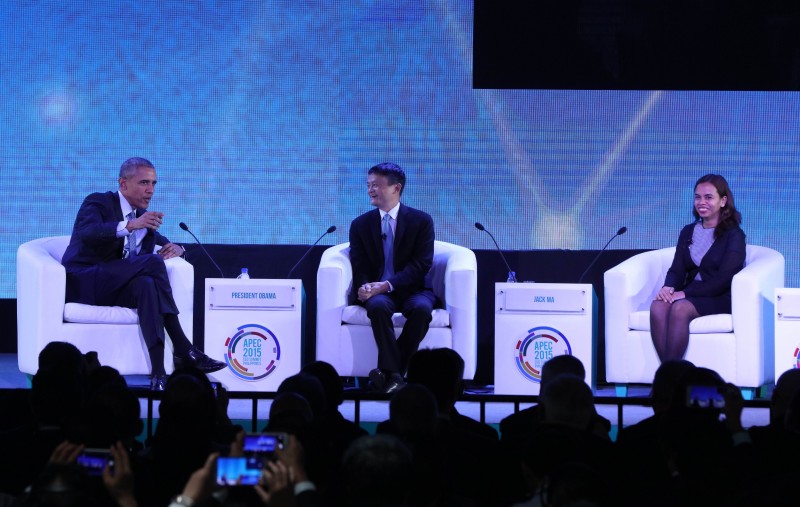Let there be light

U.S. President Barack Obama, left, and Filipina scientist Aisa Mijeno, right, listen as Alibaba founder Jack Ma, center, speaks during a discussion at the CEO Summit, attended by 800 business leaders from around the region representing U.S. and Asia-Pacific companies, in Manila, Philippines, Wednesday, Nov. 18, 2015, ahead of the start of the Asia-Pacific Economic Cooperation summit. REY S. BANIQUET
An encouraging and enduring image from last week’s Apec meetings in Manila was that of Filipino engineer Aisa Mijeno holding her own in a lively panel with US President Barack Obama and Alibaba founder Jack Ma, as they discussed SMEs (small and medium enterprises) and the private sector’s role in mitigating climate change.
More than the motherhood statements parroted in many global forums, the discussion centered on green innovations and inventions that address realities on the ground.
Mijeno’s salt-powered lamp (called SALt, for Sustainable Alternative Lighting) made up a great takeaway from the Apec event: the real meaning of “inclusive growth,” that buzz phrase used so profligately during the meetings.
SALt shows how technology can be used to serve the needs of the poor so that they, too, will benefit from the Philippines’ touted economic growth. It addresses an urgent need for electric power in remote areas: Some 16 million families are off-grid, according to a 2013 study by the Philippine Institute for Development Studies.
Mijeno’s lamp uses saltwater—which can be easily sourced from the sea by coastal communities—making it a cheap, sustainable, clean and safe alternative to kerosene, the default fuel in marginalized areas. Essentially, the saltwater facilitates the disintegration of a piece of metal (called an “anode”) immersed in the solution. The disintegration of this anode produces electricity that can provide up to eight hours of light equivalent to that provided by seven candles. The lamp also has a USB port that allows users to charge their phones when the light is turned off.
Users can replenish the saltwater solution by dissolving two tablespoons of salt in a glass of water, but the anode needs to be replaced every six months. The lamp costs about $20, plus $3 every six months for a replacement anode. (Residents of a Kalinga village had to shell out P40 every two days for kerosene.)
With a more accessible light source, people in remote communities now have a chance to pursue other activities that the onset of darkness had made near-impossible: farm chores, tending of livestock, reading and studying, even just enjoying the night breeze without fear. They can become more active partners in the national economy and be able to share in the dividends of growth. With the yearly typhoons and power outages, salt lamps literally provide a lifeline.
SALt also shows that it is imperative to know a problem intimately in order to solve it. Mijeno, a former Greenpeace campaigner and faculty member of De La Salle-Lipa, stayed with the Butbut tribe in Buscalan, Kalinga, for some time, and learned that the villagers depended mainly on moonlight for evening chores and trekked six hours to Bontoc for their kerosene supply. It’s an abiding lesson that government officials and functionaries must take to heart. (Let them immerse themselves in those MRT-LRT queues so they’d understand how urgent it is to solve the public transport problem with which ordinary wage-earners grapple daily.)
Described by Obama as an “innovator,” Mijeno is also a role model for women everywhere, one who embodies the promise of youth as a dynamic force. More than just skills, she imbues the male-dominated engineering field with heart, showing how knowledge can be harnessed for maximum good.
But Mijeno’s narrative also reveals the government’s disheartening and passive stance despite its rhetoric on green initiatives. Even with her local and international awards, Mijeno could not find enough funding support to mass-produce her invention in order to make it more affordable to poor communities. In fact, she and brother Ralph had to crowdsource the funds needed to meet their goal of providing salt lamps to the Hanunuo Mangyan tribe of Bulalacao, Oriental Mindoro; the Barangay Gabi families of Carles, Iloilo; and the Buscalan tribe of Kalinga.
It was in fact Obama’s staff who found Mijeno online and pushed her to center stage, where she met world-famous entrepreneur Jack Ma. The richest man in China promptly offered her a scholarship to an entrepreneur school in his country.
So where’s that vaunted government support for local SMEs? What are local officials doing to solve the energy problem in their communities? Why must it take outsiders—in the case of Mijeno in Kalinga, and Obama and Ma during the Apec—to find solutions to a domestic crisis? How long before they see the light?
Hopefully, Mijeno’s SALt would nudge the Aquino administration into demonstrating its commitment to inclusive growth, while finding a way to meet a most pressing need: clean and sustainable power supply.




















